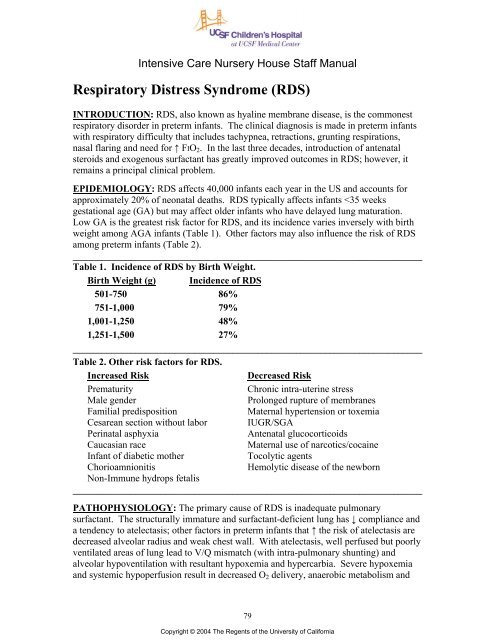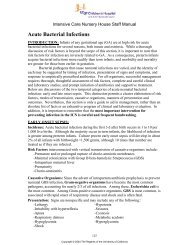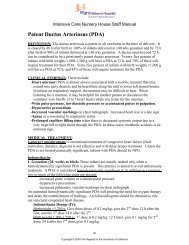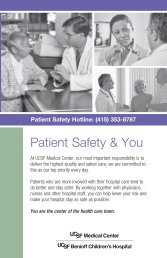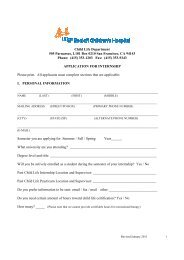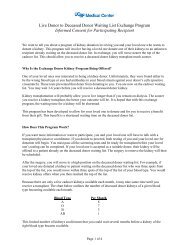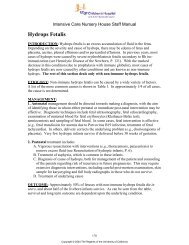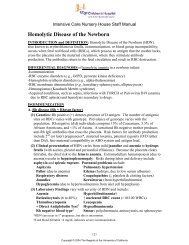Respiratory Distress Syndrome (RDS)
Respiratory Distress Syndrome (RDS)
Respiratory Distress Syndrome (RDS)
- No tags were found...
You also want an ePaper? Increase the reach of your titles
YUMPU automatically turns print PDFs into web optimized ePapers that Google loves.
Intensive Care Nursery House Staff Manual<strong>Respiratory</strong> <strong>Distress</strong> <strong>Syndrome</strong> (<strong>RDS</strong>)INTRODUCTION: <strong>RDS</strong>, also known as hyaline membrane disease, is the commonestrespiratory disorder in preterm infants. The clinical diagnosis is made in preterm infantswith respiratory difficulty that includes tachypnea, retractions, grunting respirations,nasal flaring and need for ↑ FIO 2 . In the last three decades, introduction of antenatalsteroids and exogenous surfactant has greatly improved outcomes in <strong>RDS</strong>; however, itremains a principal clinical problem.EPIDEMIOLOGY: <strong>RDS</strong> affects 40,000 infants each year in the US and accounts forapproximately 20% of neonatal deaths. <strong>RDS</strong> typically affects infants
<strong>Respiratory</strong> <strong>Distress</strong> <strong>Syndrome</strong>subsequent lactic acidosis. Hypoxemia and acidosis may further impair oxygenation bycausing pulmonary vasoconstriction, resulting in right-to-left shunting at the levels of theforamen ovale and ductus arteriosus.Other factors, such asbaro/volutrauma and high FIO 2 , mayinitiate release of inflammatorycytokines and chemokines causingmore endothelial and epithelial cellinjury. The injury results in reducedsurfactant synthesis and function aswell as increased endothelialpermeability leading to pulmonaryedema. Leakage of proteins into thealveolar space further exacerbatessurfactant deficiency by causingsurfactant inactivation.Macroscopically, the lungs appearcongested, atelectatic and solid.Microscopically, diffuse alveolaratelectasis and pulmonary edema areseen. An eosinophilic membranecomposed of a fibrinous matrix ofmaterials from the blood and cellularSurfactantDeficiencyACUTEV/Q Mismatch<strong>Respiratory</strong> &Metabolic AcidosisPulmonary VasoconstrictionImpaired endothelial andepithelial integrityProteinaceous exudateAtelactasisHypoventilationHypoxemia & Hypercarbiadebris (the hyaline membrane) lines the visible airspaces that usually constitute dilatedterminal bronchioles and alveolar ducts.CLINICAL FEATURES: Signs of <strong>RDS</strong> appear immediately after birth or within 4 h.<strong>RDS</strong> is characterized by tachypnea (>60 breaths/min), intercostal and subcostalretractions, nasal flaring, grunting, and cyanosis in room air. Tachypnea is due to anattempt to increase minute ventilation to compensate for a decreased tidal volume andincreased dead space. Retractions occur as the infant is forced to generate a highintrathoracic pressure to expand the poorly compliant lungs. Grunting results from thepartial closure of the glottis during forced expiration in an effort to maintain FRC. Afteran initial improvement with resuscitation and stabilization, an uncomplicated course isoften characterized by a progressive worsening for 48 to 72 h. Recovery usuallycoincides with a diuresis after an initial period of oliguria. Other clinical features mayinclude hypotension, acidosis and hyperkalemia. The typical chest radiograph shows lowlung volumes and a bilateral, reticular granular pattern (ground glass appearance) withsuperimposed air bronchograms. In more severe cases, there is complete “white out” ofthe lung fields. Application of positive airway pressure may minimize or even eliminatethese radiographic findings. Acute complications include air leaks and intracranialhemorrhage. Long-term, <strong>RDS</strong> has been associated with an increased incidence of chroniclung disease, ROP, and neurologic impairment.MANAGEMENT: The goals of management of an infant with <strong>RDS</strong> are to:•Avoid hypoxemia and acidosis<strong>RDS</strong>PREMATURITYStructurallyImmature LungHigh Fi0 2 & Baro or VolutraumaInflammatoryCell InfluxCytokineReleaseCHRONICLung InjuryAntioxidantReductionFree-radicalreactionsChronic Lung Disease / BPD80Copyright © 2004 The Regents of the University of California
<strong>Respiratory</strong> <strong>Distress</strong> <strong>Syndrome</strong>•Optimize fluid management: avoid fluid overload and resultant body and pulmonaryedema while averting hypovolemia and hypotension•Reduce metabolic demands and maximize nutrition•Minimize lung injury secondary due to volutrauma and oxygen toxicityThe three most important advances in prevention and treatment of <strong>RDS</strong> have been: (a)antenatal glucocorticoids, (b) continuous positive airway pressure (CPAP) and positiveend-expiratory pressure (PEEP), and (c) surfactant replacement therapy. These havedramatically decreased morbidity and mortality from <strong>RDS</strong>.1. Antenatal glucocorticoids accelerate fetal lung maturity by increasing formation andrelease of surfactant and maturing the lung morphologically. Physiologic stress levels ofcorticosteroids administered to the mother initiate a receptor-mediated induction ofspecific developmentally regulated proteins in the fetus. Administration ofglucocorticoids at least 24 to 48 h (and no more than 7 d) before preterm deliverydecreases both incidence and severity of <strong>RDS</strong>. They are most effective before 34 weeks.However, antenatal steroids should still be considered when therapy is less than 24 hbefore anticipated delivery because a reduction in neonatal mortality and <strong>RDS</strong> can stilloccur in this time frame. Repeated (>3) courses of corticosteroids have been associatedwith decreased fetal growth and poorer neurological outcomes. Antenatal steroids alsoreduce the incidence of intraventricular hemorrhage, an effect that is independent oflessened pulmonary morbidity and that may be secondary to stabilization of cerebralblood flow or maturation of cerebral vasculature. The effects of antenatal steroids andsurfactant have been demonstrated to be additive in improving lung function.2. Exogenous surfactant: It has been shown in multiple randomized controlled trials thatthe use of exogenous surfactant in preterm infants improves oxygenation, decreases airleaks, reduces mortality due to <strong>RDS</strong>, and decreases overall mortality.A. Timing of surfactant administration: Two approaches have been used forsurfactant delivery: prophylactic and rescue treatment. Prophylactic administrationinvolves giving surfactant soon after birth, as soon as the infant has been stabilized.The theoretical benefit of this approach is that replacement of surfactant before <strong>RDS</strong>develops will avoid or ameliorate lung injury. Animal studies have shown that thelung epithelium of very premature subjects can be damaged within minutes of onsetof ventilation. The damage can result in protein leak which subsequently interfereswith surfactant function. Rescue administration involves giving surfactant toinfants who have established <strong>RDS</strong> and require mechanical ventilation andsupplemental O 2 . The advantage of this approach is that patients are not treatedunnecessarily. Because surfactant currently can only be given via an endotrachealtube, this would prevent intubation and mechanical ventilation of infants who woulddo well without surfactant and avoid unnecessary baro/volutrauma, adversephysiological effects of laryngoscopy, and possible inadvertent hyperventilation. Paststudies have shown greater reduction in neonatal mortality with prophylacticadministration versus rescue, especially in infants greatest at risk for <strong>RDS</strong> (i.e.,
<strong>Respiratory</strong> <strong>Distress</strong> <strong>Syndrome</strong>with the advantages of avoiding mechanical ventilation and volutrauma. The currentapproach to the timing of surfactant therapy at UCSF is summarized in Table 3.______________________________________________________________________Table 3. Guidelines for intubation and timing of surfactant administration inpreterm infants.Gest. Age Antenatal Ventilatory Timing of(Weeks) Steroids* Treatment Surfactant≤27 No Intubate all Prophylacticinfants≤27 Yes (a) If intubation † & mech. Prophylactic, unlessvent. needed at birth in room air by age 20 min(b) Early CPAP, if not stable Rescueintubate † & mech. vent.(c) Early CPAP, if stable Do not give surfactant27-34 Yes or No Manage as for ≤27 weeks and (+) steroids>34 Use clinical assessment________________________________________________________________________*Steroid therapy indicates mother received 2 doses at least 24 h before and not more than7 d before birth.† For indications for intubation, see Table 4.________________________________________________________________________B. Administration and dose of surfactant: For prophylactic administration, theposition of the endotracheal (ET) tube should be verified by two people beforesurfactant is given. Attach the surfactant syringe to the side port of the ET tube,occlude end of ET tube, and administer surfactant as a single aliquot over ≈ 5 sec.For rescue therapy, obtain chest radiograph to confirm tube position. Administersurfactant through a feeding tube inserted to (but not past) the end of the ET tube.Administer in same manner as with prophylactic treatment. Slower administrationmay interfere with its efficacy. After administration, the infant should be handventilated and may transiently require higher ventilatory support. Several studieshave shown that two doses, 12 h apart, may be more effective than single dosetherapy. More than 2 doses is rarely required and is rarely effective. The dose ofsurfactant is:Infasurf 3mL/kgSurvanta 4 mL/kgC. Criteria for rescue treatment: Rescue treatment with surfactant should be given topreterm infants who have:•<strong>Respiratory</strong> distress, necessitating intubation and assisted ventilation,•No radiological evidence of another disease process,82Copyright © 2004 The Regents of the University of California
<strong>Respiratory</strong> <strong>Distress</strong> <strong>Syndrome</strong>and require either•FIO 2 > 0.3 or a mean airway pressure ≥7 cmH 2 OD. Complications: Although surfactant administration is relatively safe, complicationsinclude obstruction of the endotracheal tube, transient increases in O 2 requirementand ventilatory settings, and pulmonary hemorrhage, an infrequent adverse effectreported in 2-6% of infants given surfactant.3. Oxygen should be administered to preterm infants in concentrations sufficient tomaintain PaO 2 between 50-70 mmHg or saturation (by pulse oximetry) between 85-92%.Higher O 2 concentrations may exacerbate lung injury and will increase the risk ofretinopathy of prematurity.4. <strong>Respiratory</strong> Management: Please see the section on <strong>Respiratory</strong> Support (P. 10) for amore complete discussion of ventilation strategies. The initial decision in respiratorymanagement of an infant with <strong>RDS</strong> is whether the infant can be adequately managed withnasal CPAP (i.e., no treatment with surfactant) or should receive endotracheal intubation,surfactant therapy and mechanical ventilation. Endotraheal intubation should beperformed in infants that require prophylactic surfactant administration or who meet thecriteria listed in Table 4.________________________________________________________________________Table 4. Indications for intubation of preterm infant during resuscitation.________________________________________________________________________•GA ≤27 weeks and no maternal steroids•For other infants, any of the following:-Apnea-Unable to maintain an adequate airway-Requires FIO 2 >0.4 - ↑ work of breathing (grunting, retractions, flaring)-pH 60 mmHg________________________________________________________________________The goals of ventilatory management in the intubated infant are to maintain adequateoxygenation and ventilation while minimizing ventilator induced lung injury. To achievethese aims, utilize a strategy of permissive hypercarbia, maintaining PaCO 2 between 45-55 mmHg, theoretically reducing volutrauma and preventing deleterious effects ofhypocarbia. To reduce further the risk of volutrauma, adjust ventilatory pressures tomaintain tidal volume between 4-5 mL/kg. Administration of surfactant improves lungmechanics (↑ lung compliance) and increases oxygenation by reducing atelectasis andincreasing FRC. It is extremely important to recognize the time frame of these changes.After surfactant administration, there may be very rapid improvements inpulmonary function that necessitate rapid weaning of ventilator settings. Closeattention must be paid to tidal volume, blood gas tensions, transcutaneous CO 2 and pulseoximetry values in order to avoid inadvertent hyperventilation, hyperoxia and overdistensionof the lung, all of which can result in lung injury. Although it may benecessary to wean FIO 2 , inspiratory pressure and ventilator rate, one should decreasePEEP with extreme caution. Infants in the early phases of <strong>RDS</strong> will rarely maintain83Copyright © 2004 The Regents of the University of California
<strong>Respiratory</strong> <strong>Distress</strong> <strong>Syndrome</strong>adequate lung inflation if PEEP is


